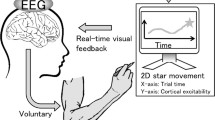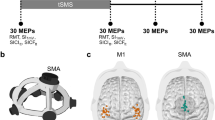Abstract
Hand dystonia is a common complication of Wilson’s disease (WD), responsible for handwriting difficulties and disability. Alteration of sensorimotor integration and overactivity of the somatosensory cortex have been demonstrated in dystonia. This study investigated the immediate after effect of an inhibitory repetitive transcranial magnetic stimulation (rTMS) applied over the somatosensory cortex on the writing function in WD patients with hand dystonia. We performed a pilot prospective randomized double-blind sham-controlled crossover rTMS study. A 20-min 1-Hz rTMS session, stereotaxically guided, was applied over the left somatosensory cortex in 13 WD patients with right dystonic writer’s cramp. After 3 days, each patient was crossed-over to the alternative treatment. Patients were clinically evaluated before and immediately after each rTMS session with the Unified Wilson’s Disease rating scale (UWDRS), the Writers’ Cramp Rating Scale (WCRS), a specifically designed scale for handwriting difficulties in Wilson’s disease patients (FAR, flow, accuracy, and rhythmicity evaluation), and a visual analog scale (VAS) for handwriting discomfort. No significant change in UWDRS, WCRS, VAS, or FAR scores was observed in patients treated with somatosensory inhibitory rTMS compared to the sham protocol. The FAR negatively correlated with UWDRS (r = −0.6; P = 0.02), but not with the WCRS score, disease duration, MRI diffusion lesions, or with atrophy scores. In our experimental conditions, a single inhibitory rTMS session applied over somatosensory cortex did not improve dystonic writer cramp in WD patients.


Similar content being viewed by others
References
Bäumer T, Demiralay C, Hidding U, Bikmullina T, Helmich RC, Wunderlich S, Rothwell J, Liepert J, Siebner HR, Münchau A (2007) Abnormal plasticity of the sensorimotor cortex to slow repetitive transcranial magnetic stimulation in patients with writer’s cramp. Mov Disord 22:81–90. doi:10.1002/mds.21219
Bleton JP, Vidailhet M, Bourdain F, Ducorps A, Schwartz D, Delmaire C, Lehericy S, Renault B, Garnero L, Meunier S (2011) Somatosensory cortical remodeling after rehabilitation and clinical benefit of in writer’s cramp. J Neurol Neurosurg Psychiatry 82:574–577. doi:10.1136/jnnp.2009.192476
Boecker H, Ceballos-Baumann A, Bartenstein P, Weindl A, Siebner HR, FassbenderT Munz F, Schwaiger M, Conrad B (1999) Sensory processing in Parkinson’s and Huntington’s disease: investigations with 3D H(2)(15)O-PET. Brain 122:1651–1665
Borich M, Arora S, Kimberley TJ (2009) Lasting effects of repeated rTMS application in focal hand dystonia. Restor Neurol Neurosci 27:55–65. doi:10.3233/RNN-2009-0461
Brandmann O, Weiss KH, Kaler SG (2015) Wilson’s disease and other neurological copper disorders. Lancet Neurol 14:103–113. doi:10.1016/S1474-4422(14)70190-5
Butterworth S, Francis S, Kelly E, McGlone F, Bowtell R, Sawle GV (2003) Abnormal cortical sensory activation in dystonia: an fMRI study. Mov Disord 18:673–682. doi:10.1002/mds.10416
Ceballos-Baumann AO, Passingham RE, Marsden CD, Brooks DJ (1995a) Motor reorganization in acquired hemidystonia. Ann Neurol 37:746–757. doi:10.1002/ana.410370608
Ceballos-Baumann AO, Passingham RE, Warner T, Playford ED, Marsden CD, Brooks DJ (1995b) Overactive prefrontal and underactive motor cortical areas in idiopathic dystonia. Ann Neurol 37:363–372. doi:10.1002/ana.410370313
Chen R, Classen J, Gerloff C, Celnik P, Wassermann EM, Hallett M, Cohen LG (1997) Depression of motor cortex excitability by low-frequency transcranial magnetic stimulation. Neurology 48:1398–1403
Chung CL, Mak MK (2016) Effect of repetitive transcranial magnetic stimulation on physical function and motor signs in Parkinson’s disease: a systematic review and meta-analysis. Brain Stimul 9:475–487. doi:10.1016/j.brs.2016.03.017
Członkowska A, Tarnacka B, Möller JC, Leinweber B, Bandmann O, Woimant F, Oertel WH (2007) Unified Wilson’s Disease Rating Scale—a proposal for the neurological scoring of Wilson’s disease patients. Neurol Neurochir Pol 41:1–12
Ferenci P, Caca K, Loudianos G, Mieli-Vergani G, Tanner S, Sterlieb Schilsky M, Cox D, Berr F (2003) Diagnosis and phenotypic classification of Wilson disease. Liver Int 23:139–142
Garraux G, Bauer A, Hanakawa T, Wu T, Kansaku K, Hallett M (2004) Changes in brain anatomy in focal hand dystonia. Ann Neurol 55:736–739. doi:10.1002/ana.20113
Harlett M (1995) Is dystonia a sensory disorder? Ann Neurol 38:139–140. doi:10.1002/ana.410380203
Haslinger B, Altenmüller E, Castrop F, Zimmer C, Dresel C (2010) Sensorimotor overactivity as a pathophysiologic trait of embouchure dystonia. Neurology 74:1790–1797
Havrankova P, Jech R, Walker ND, Operto G, Tauchmanova J, Vymazal J, Dusek P, Hromcik M, Ruzicka E (2010) Repetitive TMS of the somatosensory cortex improves writer’s cramp and enhances cortical activity. Neuro Endocrinol Lett 31:73–86
Hölscher S, Leinweber B, Hefter H, Reuner U, Günther P, Weiss KH, Oertel WH, Möller JC (2010) Evaluation of the symptomatic treatment of residual neurological symptoms in Wilson disease. Eur Neurol 64:83–87. doi:10.1159/000316066
Huang YZ, Lu CS, Rothwell JC, Lo CC, Chuang WL, Weng YH, Lai SC, Chen RS (2012) Modulation of the disturbed motor network in dystonia by multisession suppression of premotor cortex. PLoS One 7(10):e47574. doi:10.1371/journal.pone.0047574
Jinnah HA, Hess EJ (2006) A new twist on the anatomy of dystonia: the basal ganglia and the cerebellum? Neurology 67:1740–1741. doi:10.1212/01.wnl.0000246112.19504.61
Kaji R, Rothwell JC, Katayama M, Ikeda T, Kubori T, Kohara N, Mezaki T, Shibasaki H, Kimura J (1995) Tonic vibration reflex and muscle afferent block in writer’s cramp. Ann Neurol 38:155–162. doi:10.1002/ana.410380206
Kimberley TJ, Borich MR, Arora S, Siebner HR (2013) Multiple sessions of low-frequency repetitive transcranial magnetic stimulation in focal hand dystonia: clinical and physiological effects. Restor Neurol Neurosci 31:533–542. doi:10.3233/RNN-120259
Knecht S, Ellger T, Breitenstein C, Bernd Ringelstein E, Henningsen H (2003) Changing cortical excitability with low-frequency transcranial magnetic stimulation can induce sustained disruption of tactile perception. Biol Psychiatry 53:175–179
Kruisdijk JJ, Koelman JH, Ongerboer de Visser BW, de Haan RJ, Speelman JD (2007) Botulinum toxin for writer’s cramp: a randomised, placebo-controlled trial and 1-year follow-up. J Neurol Neurosurg Psychiatry 78:264–270
Leinweber B, Möller JC, Scherag A, Reuner U, Günther P, Lang CJ, Schmidt HH, Schrader C, Brandmann O, Czlonkowska A, Oertel WH, Hefter H (2008) Evaluation of the Unified Wilson’s Disease Rating Scale (UWDRS) in German patients with treated Wilson’s disease. Mov Disord 23:54–62. doi:10.1002/mds.21761
Litwin T, Dusek P, Czlonkowska A (2016) Neurological manifestations in Wilson’s disease—possible treatment options for symptoms. Expert Opin Orphan Drugs. doi:10.1080/21678707.2016.1188003
Lozeron P, Poujois A, Richard A, Masmoudi S, Meppiel E, Woimant F, Kubis N (2016) Contribution of TMS and rTMS in the understanding of the pathophysiology and in the treatment of dystonia. Front Neural Circuits 10:90. doi:10.3389/fncir.2016.00090
Machado A, Chien HF, Deguti MM, Cancado E, Azevedo RS, Scaff M, Barbosa ER (2006) Neurological manifestations in Wilson’s disease: report of 119 cases. Mov Disord 21:2192–2196. doi:10.1002/mds.21170
Murase N, Rothwell JC, Kaji R, Urushihara R, Nakamura K, Murayama N, Igasaki T, Sakata-Igasaki M, Mima T, Ikeda A, Shibasaki H (2005) Subthreshold low-frequency repetitive transcranial magnetic stimulation over the premotor cortex modulates writer’s cramp. Brain 128:104–115
Obeso I, Cerasa A, Quattrone A (2016) The effectiveness of transcranial brain stimulation in improving clinical signs of hyperkinetic movement disorders. Front Neurosci 9:486. doi:10.3389/fnins.2015.00486
Poujois A, Devedjian JC, Moreau C, Devos D, Chaine P, Woimant F, Duce JA (2016) Bioavailable trace metals in neurological diseases. Curr Treat Options Neurol 10:46. doi:10.1007/s11940-016-0426-1
Schneider SA, Pleger B, Draganski B, Cordivari C, Rothwell JC, Bathia KP, Dolan RG (2010) Modulatory effects of 5 Hz rTMS over the primary somatosensory cortex in focal dystonia—an fMRI–TMS study. Mov Disord 25:76–83. doi:10.1002/mds.22825
Siebner HR, Tormos JM, Ceballos-Baumann AO, Auer C, Catala MD, Conrad B, Pascual-Leone A (1999) Low-frequency repetitive transcranial magnetic stimulation of the motor cortex in writer’s cramp. Neurology 52:529–537
Sinha S, Taly AB, Ravishankar S, Prashanth LK, Venugopal KS, Arunodaya GR, Vasudev MK, Swamy HS (2006) Wilson’s disease: cranial MRI observations and clinical correlation. Neuroradiology 48:613–621. doi:10.1007/s00234-006-0101-4
Svetel M, Kozić D, Stefanova E, Semnic R, Dragasevic N, Kostic VS (2001) Dystonia in Wilson’s disease. Mov Disord 16:719–723
Taly AB, Meenakshi SS, Sinha S (2007) Wilson disease: description of 282 patients evaluated over 3 decades. Medicine 82:112–121
Tyvaert L, Houdayer E, Devanne H, Monaca C, Cassim F, Derambure P (2006) The effect of repetitive transcranial magnetic stimulation on dystonia: a clinical and pathophysiological approach. Neurophysiol Clin 36:135–143. doi:10.1016/j.neucli.2006.08.007
Weiss KH, Stremmel W (2014) Clinical considerations for an effective medical therapy in Wilson’s disease. In: Kaler SG, Lutsenko S, Schilsky ML, Thiele DJ, Huster D (eds) Ann N Y Acad Sci 1315:81–85
Weiss KH, Thurik F, Gotthardt DN, Schäffer M, Teufel U, Wiegrand F, Merle U, Ferenci-Foerster D, Maieron A, Stauber R, Zoller H, Schmidt HH, Reuner U, Hefter H, Trocello JM, Houwen RH, Ferenci P, Stremmel W, EUROWILSON Consortium (2013) Efficacy and safety of oral chelators in treatment of patients with Wilson disease. Clin Gastroenterol Hepatol 11:1028–1035. doi:10.1016/j.cgh.2013.03.012
Wissel J, Kabus C, Wenzel R, Klepsch S, Swartz U, Nebe A, Schelosky L, Scholz U, Poewe W (1996) Botulinum toxin in writer’s cramp: objective response evaluation in 31 patients. J Neurol Neurosurg Psychiatry 61:172–175
Acknowledgements
Funding sources for the study: French Ministry of Health, Programme Hospitalier de Recherche Clinique, and Assistance Publique des Hôpitaux de Paris (CIRC P121105). We are grateful to Mr. Loïc Bruyser for technical support.
Author information
Authors and Affiliations
Corresponding author
Ethics declarations
Conflict of interest
PL received consultancies fees from ‘CSL Behring’, travel grants from ‘CSL Behring’, and ‘LFB biomedicaments’ and speaker honoraria from ‘Astellas’. AP received consultancies fees from ‘Univar’, travel grants from ‘Merz’ and ‘Allergan’, and speaker honoraria from ‘Univar’. EM declares that she has no conflict of interest. SM received financial support from ‘humanair medical’ to attend SFRMS meeting, and financial support from ‘Sanofi’ to attend “Les Rencontres de Neurologie” meeting. TPM declares that he has no conflict of interest. EV received consultancies fees and/or speaker honoraria from ‘Bayer Health care’, ‘Bristol-Myers Squibb’, ‘Daiichi-Sankyo’, ‘Johnson&Johnson’, ‘Innothera’, and ‘Pfizer’.AP received consultancies fees from Univar, travel grants from Merz and speaker honoraria from Univar. EH declares that he has no conflict of interest. FW declares that she has no conflict of interest. JMT received consultancies fees from ‘Allergan’ and ‘Aguettant’. JPG declares that he has no conflict of interest. NK received financial support from ‘CSL Behring’ to attend SFN meeting.
Research involving human participants and/or animals
All procedures performed in studies involving human participants were in accordance with the ethical standards of the institutional and/or national research committee and with the 1964 Helsinki declaration and its later amendments or comparable ethical standards.
Informed consent
Informed consent was obtained from all individual participants included in the study.
Electronic supplementary material
Below is the link to the electronic supplementary material.
Rights and permissions
About this article
Cite this article
Lozeron, P., Poujois, A., Meppiel, E. et al. Inhibitory rTMS applied on somatosensory cortex in Wilson’s disease patients with hand dystonia. J Neural Transm 124, 1161–1170 (2017). https://doi.org/10.1007/s00702-017-1756-1
Received:
Accepted:
Published:
Issue Date:
DOI: https://doi.org/10.1007/s00702-017-1756-1




